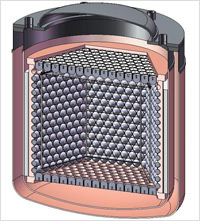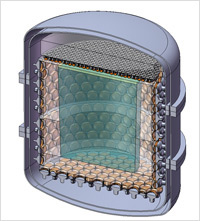MAX Technology
Researchers of the MAX collaboration are engineering two similar detectors to search for dark matter. The scientists will fill each of the two detectors with a noble liquid, one with argon and the other with xenon. If a particle of dark matter interacts with the nucleus of an argon or xenon atom in one of the detectors, the two will collide like billiard balls. The dark matter particle will transfer a good portion of its initial velocity – a few hundred kilometers per second – to the atom, and the dark matter particle will slow down. The atom will travel through the noble liquid, emitting a few photons and separating a few electrons from the surrounding ions. Both detectors can measure the photons and electrons knocked loose through particle interactions and can determine the energy and physical location of the interaction.
The detectors will share the same photosensor technology, electronics, shielding scheme and purification strategy. But they will differ in operating temperature to prevent the noble liquids from boiling. Argon boils at 87 K, or minus 189 C, and xenon boils at 165 K, or minus 108 C. The detectors also will use separate methods of collecting light, as argon emits a far ultraviolet light and xenon emits a near ultraviolet light.
The MAX collaboration plans to make use of the combined strength of the two noble liquids. The simultaneous observation of the interaction rates on a light atom – argon – and heavy atom – xenon – will allow the MAX researchers to infer properties of dark matter particles, such as mass and cross section.
Scientists also plan to take advantage of xenon particles’ spin. Particles of argon have a net zero spin, so if an interaction with dark matter requires the particle to have spin, scientists will need to use atoms like xenon to find them.
Both argon and xenon offer unique capabilities in the detection and identification of dark matter. The strength of argon is its ability to discern between photons and electrons emitted by atoms traveling in liquid argon and those emitted by natural radioactivity. The strength of the xenon detector is that xenon atoms have much heavier nuclei than argon atoms, making them bigger targets for dark matter. The higher density of liquid xenon also helps to suppress the penetration of natural radioactivity.
Scientists theorize that dark matter particles are weakly interacting, meaning that they only very rarely interact with other matter. The signal from WIMP dark matter may be as minute as to cause only a few interactions per year in many tons of liquid argon or liquid xenon.
The MAX collaboration will improve on past dark matter searches in two ways. For one, MAX researchers have discovered an underground source of argon that lacks a radioactive isotope often found in argon. Most argon used in the laboratory is distilled from air, which contains an isotope with a low level of radioactivity caused by cosmic ray collisions with the atmosphere. Cosmic rays are high-energy particles from space that strike the upper layers of the atmosphere. The radioactivity can cause distracting background noise in the experiment. But it is strongly reduced in underground argon, as it is protected by many thousands of feet of rock.
The MAX collaboration has improved the way their experiments will read light signals as well. Traditional photomuliplier tubes have caused serious problems to the experimenters in the past. They contain trace amounts of uranium and thorium, which produce neutrons. Neutrons are a dark matter explorer’s worst enemy; they can produce a nuclear recoil, similar to dark matter. MAX researchers have invented and developed, in cooperation with Hamamatsu Corporation, a zero-background hybrid photomultiplier tube. The Quartz Photon Intensifying Detector, or QUPID, is built of fused silica and germanium and does not contribute to background signals like traditional photomultipliers.






